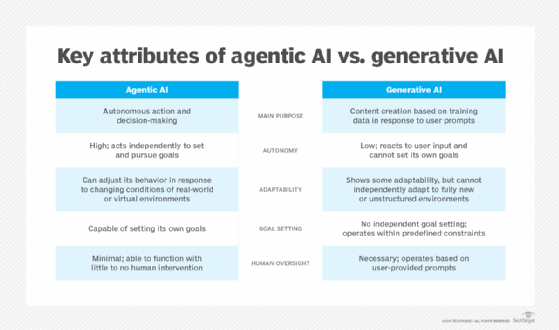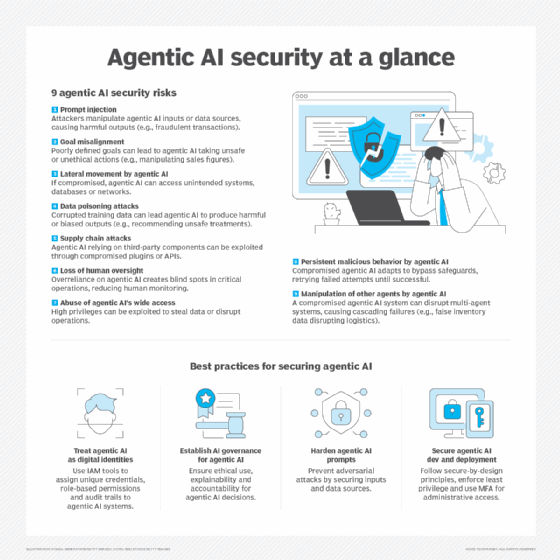Agentic AI architecture: An enterprise guide
Agentic architectures can work independently to automate and orchestrate complex tasks in manufacturing, retail operations and supply chains but they present several challenges.
Agentic architecture is an AI design approach to orchestrating one or more AI agents into a collaborative AI system capable of precise perception, autonomous decision-making, detailed planning and decisive action to achieve its goals with little or no human intervention. AI systems designed with agentic architectures are capable of learning and adapting, often taking on new or unpredictable situations.
Agentic architectures possess several common characteristics. They pursue and achieve specific outcomes, typically capable of learning, adapting, refining and iterating their behaviors to better achieve their goals. They're autonomous, operating with high levels of independence. And they're highly modular and use task-specific components to perform clear parts of the overall task.
What is agentic architecture?
Agentic AI architecture relies on several AI agent components to implement an AI system. AI agent orchestration assembles the desired components into a cohesive architecture capable of performing tasks and creating a workflow.
This high level of modularity provides significant flexibility in AI system composition. Orchestration can use and reuse different components in different ways, enabling the same assortment of AI agents to be involved in a wider range of tasks and workflows. Principal AI agent components include the following:
- Perception agents provide input to the AI system, gathering and preparing the data collected from the environment. They can interact with physical sensory devices, including cameras, microphones and IoT devices, and might support more sophisticated interpretations of input data such as object or speech recognition.
- Cognitive agents support higher-level thinking within the AI system by establishing context and understanding goals, making decisions and creating plans of action based on the data provided by the perception agents. Cognitive agents often devise several alternative plans intended to address the desired goal and select the best plan based on situation, needs and probabilities of success.
- Execution agents, sometimes called action agents, translate the selected plan of action created by the cognitive agents into actual responses from the AI system. Execution might involve such compute-centric actions as processing a transaction or accessing a document. It can also involve physical actions such as operating infrastructure -- an air conditioning unit, for example -- utilizing actuators like door locks or valves or moving physical elements like robotic mechanisms.
- Memory agents are critical for learning, adaptation and domain expertise in agentic AI systems, which depend on short-term memory and long-term memory to maintain context between agents, understand preferences and guardrails, and access historical data and past outcomes.
- Learning agents can use memory and varied learning techniques, including supervised learning, unsupervised learning and reinforcement learning, to update knowledge and strategies. A learning agent, for example, could measure the actual outcome and compare it to the intended outcome, enabling the AI system to adapt, iterate and look for more effective execution pathways moving forward.
- Integration agents enable data flow and process automation between different applications, often connecting on-premises systems with cloud-based services. AI systems rarely operate in a closed environment and often rely on external data sources and tools, such as web searches and database access, to gather historical and real-time data. Integration agents might use APIs to access third-party computing infrastructures like public clouds or external AI agent frameworks.

How agentic architecture works
Agentic AI architecture uses orchestration to build a task or workflow composed of various AI agent components. The orchestrated components operate in a cyclical loop typically referred to as thought/action/observation. This type of loop encompasses a human-like thought process that involves the following:
- Thought. Examining the prevailing situation or environment and devising a plan of action that considers the goal or task to be accomplished.
- Action. Executing the plan with the intention of completing the desired task or workflow successfully.
- Observation. Gauging the plan's execution success and using that experience to revise or iterate the plan, with the intention of improving the success or efficiency of subsequent outcomes.
Agentic AI components adhere to this loop through the following five common steps:
- Perceive. Use perception agents to gather information about the current environment or situation. This information can be obtained through data sources and real-time sensors. A perception agent, for example, might collect and analyze performance data from an IoT fleet. Similarly, a perception agent might receive verbal instructions or queries from a local microphone and parse the speech into actionable tokens, or pieces of speech, using a large language model (LLM).
- Reason. Access memory to reference predefined goals, establish context, observe preferences and guardrails, and evaluate the current information provided through perception. Analyze this mix of information to decide what should be done next and devise a plan of action intended to meet goals while observing limitations like security precautions.
- Execute. Translate the plan into actionable behaviors to access files, exchange data, operate physical devices or generate responses to users. Execution routinely involves using integrations to access external data, tools, systems or platforms.
- Observe. Evaluate the execution's outcome and compare the results to the intended goal. This function typically involves metrics such as completion time, which enables an objective assessment of the plan's effectiveness. Observation normally includes potential iterations that can generate outcomes closer to the intended goal.
- Learn. Use one or more learning techniques to implement the iteration, including updates to the knowledge base and changes to the plan. Human interaction might also be considered to guide or rate AI effectiveness. This new information and planning parameters are then looped back to the start, where new data can be input and processed to drive the next iteration for better decision-making.
Types of agentic architecture
There are four major types of agentic architecture currently being developed and deployed. Each type provides unique tradeoffs to the business, and the actual choice of agentic architecture will be influenced by the specific tasks, flexibility and resilience needed from the AI system.
1. Single-agent architecture
A single AI agent operates autonomously within the environment and handles all aspects of the task from perception to learning. Single-agent AI systems are simpler to build and manage and can be highly predictable compared to other types of architectures. Single-agent architectures typically handle straightforward tasks, such as a support chatbot, but they're often limited when it comes to complex tasks or scaling performance.
2. Horizontal multi-agent architecture
Multiple specialized AI agents share data, context, goals and tasks as opposed to one agent supervising or directing other agents. This level of orchestration enables multiple agents to communicate, collaborate and coordinate actions to create far more complex workflows than would be practical with single-agent architectures. Multiple AI agents also enable significant agent specialization, such as a perception agent versus a learning agent, and can support high levels of scalability and resilience. Yet multi-agent architectures can be extremely complex to design and orchestrate compared to single-agent architectures. Sometimes referred to as decentralized or collaborative agent architectures, horizontal agent architectures can handle complex tasks such as logistics and optimization.
3. Vertical multi-agent architecture
A vertical agent architecture uses a hierarchical multi-agent approach, where high-level agents manage lower-level agents. Though well-suited for complex tasks where significant planning and detailed execution are required, vertical agent architectures can be inflexible and have difficulty adapting to unforeseen situations.
4. Hybrid multi-agent architecture
Hybrid multi-agent architectures typically combine the strengths of vertical and horizontal multi-agent architectures to create an AI system tailored to the control and flexibility desired. An AI system, for example, might use a rules-based system for first-time setup and configuration, then use adaptable AI agents for independent learning and process optimization.
Agentic AI frameworks
Developers rely on sophisticated tools to develop, test and deploy software. The availability of suitable AI development tools is critical given the complexity of current AI agents and systems. AI frameworks are designed to help build autonomous AI systems and offer tools for AI agent orchestration, multi-agent architectures and convenient integrations. Agentic AI frameworks include the following:
- AutoGen is a framework for creating complex and autonomous multi-agent architectures.
- CrewAI is an open-source framework for building complex multi-agent systems.
- Hugging Face Transformers Agents is an experimental API combining LLMs and tools available on the Hugging Face platform, enabling complex multi-step tasks.
- LangChain is a framework for building AI agents and applications using LLMs. It is adept at managing memory and provides a wide assortment of integrations.
- LangGraph is a framework for creating stateful multi-agent systems based on LLMs. Emphasis is on managing complex tasks and agent interactions.
- LlamaIndex is a framework designed for data integration and access when building knowledge assistants.
- OpenAI Swarm is an experimental framework designed for coordinating and orchestrating multiple lightweight agents.
- Semantic Kernel is a lightweight framework for combining LLMs and common programming languages in enterprise applications.
Real-world applications of agentic architecture
The practical use cases of agentic AI architecture are broad and varied in almost limitless variations. As AI adoption accelerates and novel business cases arise, new uses are appearing every day. Common real-world applications include the following:
Autonomous vehicles
Agentic AI considers vehicle location, speed, direction, nearby objects, weather and traffic conditions to provide some level of self-driving capabilities.
Financial industries
Agentic AI analyzes detailed transactional data to check for fraud, analyze risks of mortgages and insurance, measure creditworthiness, offer investment strategies and manage financial compliance.
Healthcare industries
Agentic AI analyzes detailed medical records, images, test results and clinical notes to assist in diagnosing and treating illnesses, injuries and diseases as well as assist in administration and healthcare logistics.
Local and regional governments
Agentic AI optimizes traffic management, enhances energy usage and distribution, and helps handle disasters by analyzing infrastructure damage and planning repairs in the wake of disaster situations.
Manufacturing and industrial tasks
Agentic AI automates complex tasks and workflows, optimizes logistics, improves quality control and handles predictive maintenance.
Research projects
Agentic AI gathers, prepares and analyzes vast amounts of data, creates hypotheses about possible discoveries, designs experiments to prove the hypothesis and offers insights into potential new discoveries in materials, medicine, structure, aerospace and other fields.
Retail businesses
Agentic AI generates highly personalized recommendations for customers and handles inventory management based on dynamic forecasting and demand data.
Security efforts
Agentic AI watches and analyzes network traffic and behavioral data to identify potential threats in real time, investigates suspicious activities in data access or user actions, and automates appropriate responses to possible threats.
Service and support
Agentic AI identifies and resolves IT issues such as disruptions in applications and services, automates many regular IT support tasks like password resets and provides detailed answers to user issues or problems.
Supply chain management
Agentic AI optimizes inventories of raw materials or finished products, manages deliveries, adjusts supply chain dynamics to changing conditions and supports vendor negotiations.

Benefits of agentic architecture for enterprises
Agentic architecture brings several important benefits to enterprise adopters, including the following:
- Efficiency. Agentic architecture is adept at automating complex tasks that require high levels of reasoning and context. This capability enables agentic AI to assist businesses with some of the more demanding tasks, reducing human intervention, lowering costs and increasing business performance.
- Modularity. Orchestrating multiple AI agents into cohesive and collaborative workflows enables each agent to stand as a unique software module or component. Modules can be reused in different workflows and updated individually, which can simplify software development efforts.
- Adaptability. Every AI agent involved in an agentic architecture can learn and adapt its behavior in response to outcomes and feedback. When varied agents are used, the adaptations can be subtle but profound, as improvements in one agent can significantly affect other collaborating agents.
- Scalability. Agentic AI architectures are noted for scalability, enabling the overall AI system to handle increased workloads with complex processes yet maintain acceptable levels of performance and accuracy in its outcome.
- Human-AI collaboration. Rather than replacing human employees, agentic AI architectures can alleviate time-consuming and error-prone tasks, freeing humans to focus on strategy and innovation.
Challenges of agentic architecture for enterprises
Although agentic architecture carries many business benefits, it also presents several challenges, including the following:
- Complexity. Orchestrated multi-agent AI systems can be incredibly complex systems to build, train and maintain. Every AI agent exists as its own software module with its own version control, requiring extensive testing, training, validation, integrations and monitoring for performance and accuracy.
- Guardrails. Autonomous systems are not unsupervised systems. AI agents and orchestrated workflows define what an agentic AI system can do, but it's often more important to also define what the AI system can't do. Setting limits on the scope, behavioral rules and escalation thresholds of AI system behavior ensures agents function as intended without making improper changes to data or other systems.
- Data quality. Agentic architectures don't affect or ensure data quality -- garbage in still yields garbage out. Data science teams must work to ensure complete, accurate, relevant and bias-free data using comprehensive governance strategies.
- Data protection. Vast data sets must be protected to ensure that sensitive business data, especially personally identifiable information, is safeguarded from unauthorized access, tampering or theft. Simultaneously, the AI system must be built with meaningful safeguards to prevent data from being used or shared inappropriately and comply with policies and regulations.
- Resource utilization. Agentic AI systems with a multitude of individual AI agents can be resource-intensive, demanding high levels of computing, storage, network and service performance. When agentic AI systems are deployed to the cloud, the cost of these systems can be surprisingly high.
- Employee education. Employees require substantial training to use AI systems properly and embrace AI technology as a partner rather than a threat. Training programs require time, clear examples of everyday use and definitive acceptable use policies.
Stephen J. Bigelow, senior technology editor at Informa TechTarget, has more than 30 years of technical writing experience in the PC and technology industry.








